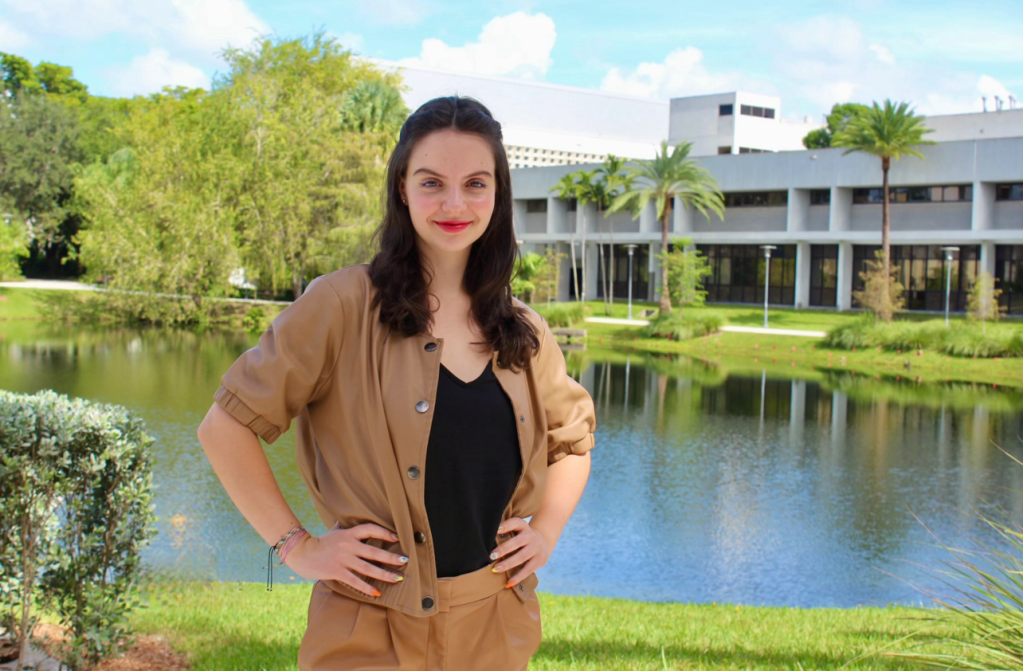
Mariya is a rising Junior enrolled in The Honors College at Florida International University pursuing a degree studying in International Relations and Philosophy. Originally from Almaty, Kazakhstan, six years ago Mariya moved to a small city Fort Myers, where she completed a High School degree with the International Baccalaureate diploma. She then decided to continue her adventures in the city that is the center of art and culture – Miami. Miami, in her opinion, has a vibrant energy that many people cannot see due to the first layers of the city. Because of that many people oversee the diversity that the city hold, and Mariya’s goal is to show the world’s beauty through art and culture at places as such.
Art Encounter As Text
“Embracing the Artistic Character” by Mariya Shevchenko on January 25, 2024
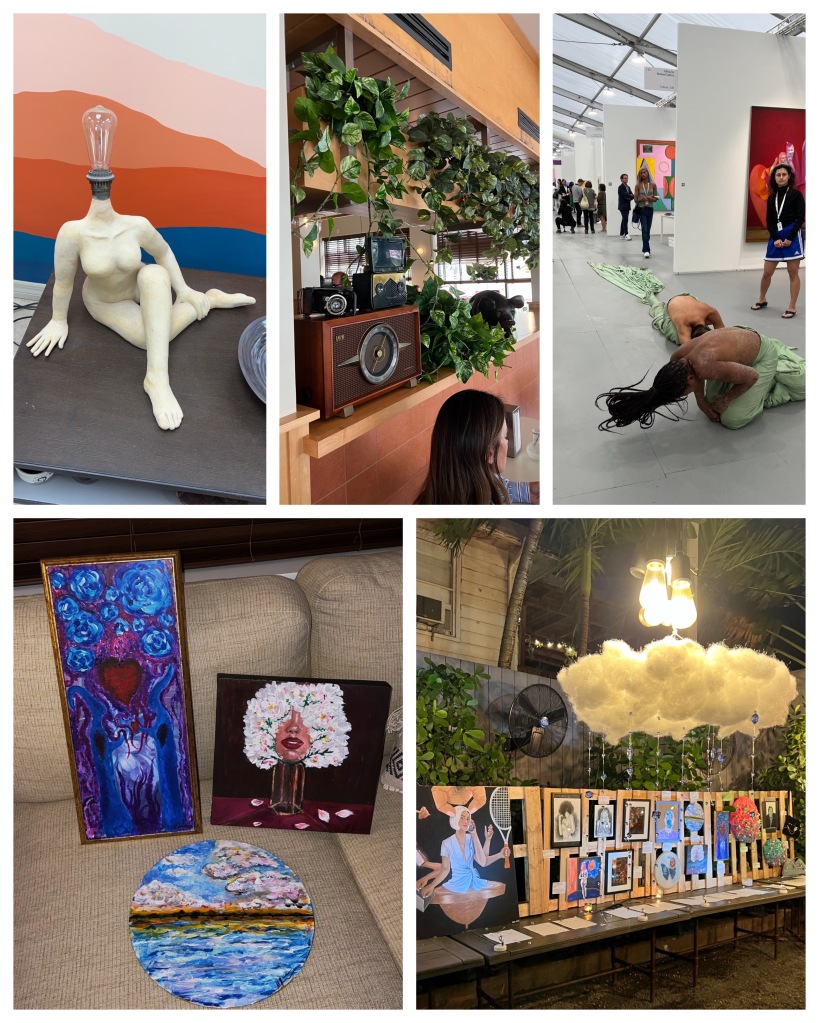
For me, it is hard to imagine the vibrant city of Miami being apart from art. From Lake Okeechobee southward to Florida Bay, and from the kaleidoscope of painted walls in Wynwood to the annual “Art Basel” galleries, street art, and the architectural giants, each element resonates with the cultural heartbeat of Miami. Living in this city as a student artist is undeniably a privilege, but one that carries a substantial cost—not merely in financial terms, but in the pursuit of carving out an identity that captivates an audience. Having moved to Miami in my freshman year of 2022, I did not know much about Miami before, rather I had stereotypical views before I learned about its history, and now I appreciate this city. While I saw the highs and lows of being here, I now can be proud of embracing this city for its unique character.
Through all the ups and downs, the one thing that never ceased to captivate me was Miami’s vibrant art scene. Being an artist myself, I thought it would be a perfect place to explore my potential, and I was not wrong. As far as being an appreciator of art, I have also contributed to Earthy Art of Miami, where I crafted pieces from upcycled materials, as well as had an opportunity to secure an internship with The Untitled Art Fairs. It’s a reminder to everyone that, regardless of where life leads, never miss any opportunities you are given. In my opinion in the realm of culture, art takes center stage, especially here in Miami where art is not just a thing—it is what invented new ways of thinking.
I learned a lot of history about Miami as a city last semester, and this semester I wanted to immerse myself in the city’s different versions of what exactly is art in Miami. Because I always remember how I liked to pick up a paintbrush as a little kid, however, I never really envisioned that I would delve into something as exciting as learning about art here in Miami. Now, reflecting on my journey in Miami, I want to say while art is a part of this city, it is essential to learn about its history, and lots of it comes from people like Mary Brickell, Barbara Baer Capitman, Dana Dorsey, etc., that contributed to this city so much, that way we can enjoy its beauty today.
My journey has revealed Miami’s evolution in contemporary art, and this evolution is not a mere coincidence but a testament to the indomitable spirit of many extraordinary women who have preserved and propelled the city’s artistic identity. The diversity of cultures here creates an irresistibly attractive tapestry that sets Miami apart. In Miami, art is not merely an expression; it’s a living of many artists, a breathing entity shaped by the interplay of cultures, and it encourages individuals to become part of its narrative. Miami has taught me that being a resident here is not just about creating; it’s about learning its history, contributing to a legacy, being inspired by the heroic women who have paved the way, and embracing the dynamic fusion of cultures that defines art in the city of Miami.
Norton Museum As Text
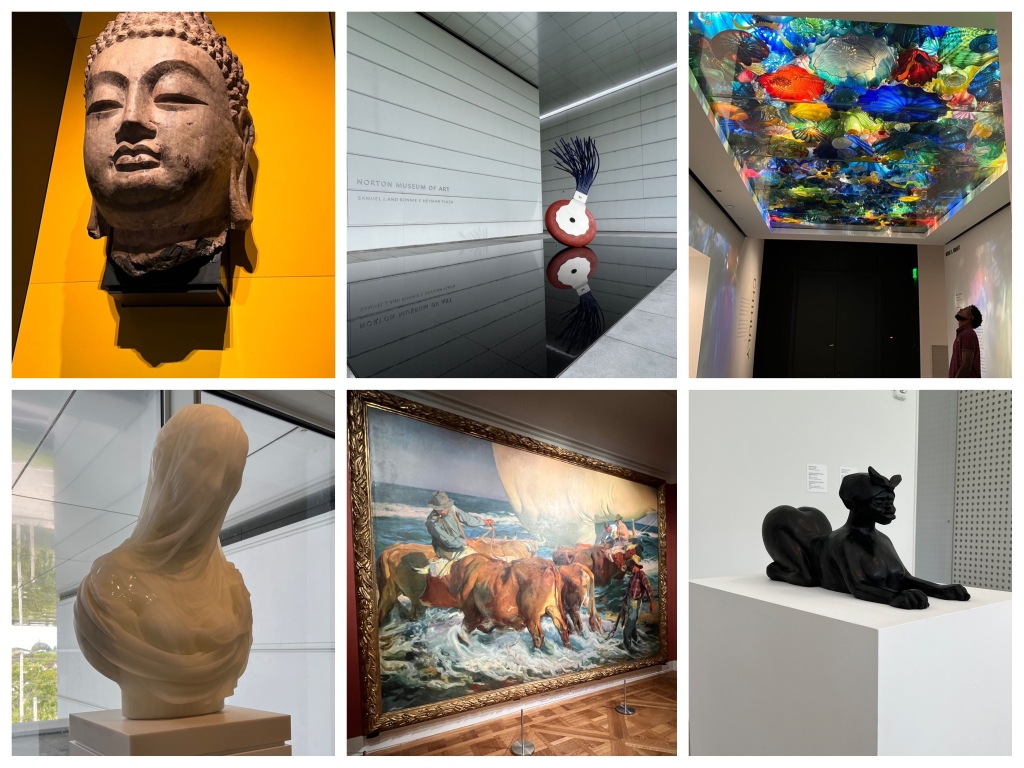
“This Blonde Hair” by Mariya Shevchenko on February 4th, 2024
I marked my second visit to the Norton Museum of Art in West Palm Beach, and once again, the experience left an even more profound impression on me than before. The story of the museum takes place in 1941, established by Ralph Hubbard Norton and his wife Elizabeth Calhoun Norton. Mr. Norton, an industrialist leading the Acme Steel Company in Chicago, initially collected art for their home, and as the collection expanded, the couple made the decision to establish a museum in 1935, making it South Florida’s first art institution.
What sets the Norton Museum apart is its distinction as the only museum of its kind in the state of Florida. The vast collection spans Western European art from the 1300s to the present day, alongside an extensive array of Chinese art, covering more than 5,000 years and featuring over 700 pieces. The juxtaposition of these two cultures shows the differences in artistic perspectives, and while Chinese artists employed imaginative creations such as dragons and artiodactyls made of bronze with unique anatomy, Western artists, particularly during the Renaissance, leaned towards realistic depictions of humans, considering them more aesthetically valuable.
The evolution of aesthetic art across ages became my main goal of my exploration at the Norton Museum. Artists like Nosadella and Giordano played very important roles in shaping their respective eras during the Renaissance, specifically by portrayals of biblical figures, such as Madonna and baby Christ. Notably, despite the anecdote of Madonna being based on a real person without a bright reputation, the artwork itself garnered significant fame and still carries history within.
Moving on further, I really took into consideration an individual artistic style of one Baroque painter – Ruben and his masterpiece, “Saint John the Evangelist.” This painting is such a good example, because it emphasizes how correctly the light is supposed to be seen in the painting. Saint John’s blond hair had me speechless because of that painting! However, the characteristics of Baroque painting, marked by strong contrast, vibrant colors, and an evocation of activity, stood in stark contrast to Panini’s “Capriccio with Monuments of Rome,” embodying the Neoclassical period. There, I noticed how many artists wanted to experience something new and completely remove still figures, while utilizing architectural capriccio, and abandoning strict geographical accuracy.
Impressionism, which was another important style to consider, was an example of Monet’s departure from traditional painting techniques into a revolutionary moment in art history. His “Nympheas” from 1905 challenged perspectives, offering a dynamic experience that transformed depending on one’s proximity to the painting. This exemplified the essence of the Impressionist movement, capturing the effects of light and atmospheric conditions, fundamentally altering the viewer’s perception. I certainly did not expect to see the painting in two different conditions when looking at it closely and from a distance.
But one painting that left me sitting there for a couple of minutes was a masterpiece by Joaqui Sorolla y Bastida. His “Beaching the Boat” painting is one of those great examples that moves your eyes around the painting but never off of it. The way the painting is completed is through such little details as, in the sun-kissed skin of the humans who have spent considerable time in the sun and the finely rendered fur of the animals. The painting, with its careful consideration of every element, forms a harmonious and complete circle that beckons viewers to traverse its details repeatedly. It is truly wonderful and is very unique to be an artist that does the job as they were called.
I think that Norton Museum is that unique place where you see arts evolution take such different turns in history like nowhere else. It goes beyond showcasing revolutionary painters who have left an indelible mark on history; it also offers a rich experience for art enthusiasts eager to delve into the roots of genuine art beyond contemporary surroundings. Despite having been there before, the museum left a lasting impact on me, imparting knowledge that I didn’t fully grasp during my initial visit.
Margulies As Text
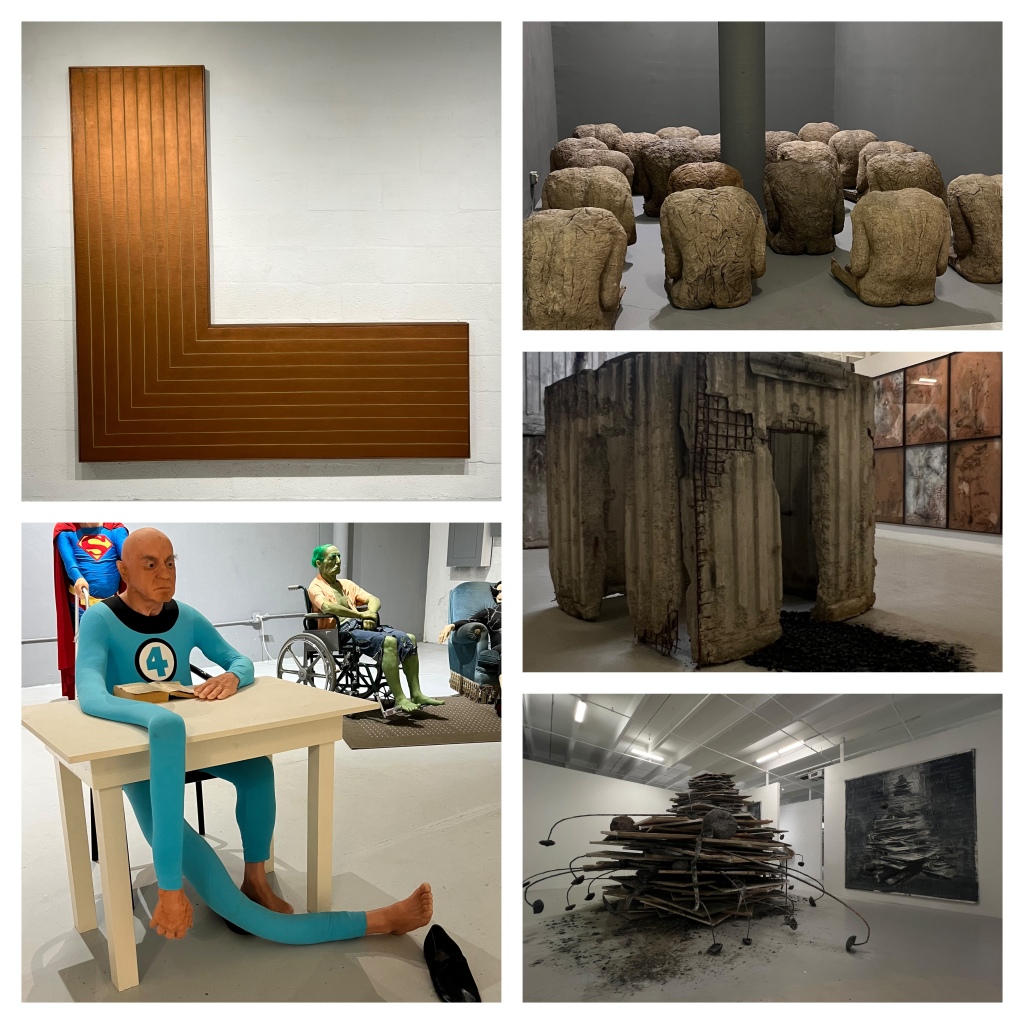
“The Idea” by Mariya Shevchenko on February 18, 2024
“I created it, but I didn’t make it” by Marcel Duchamp.
This was my first time entering The Margulies Collection at the Warehouse, which was like finding a secret gem of creative genius. I was fascinated by the history of invention and imagination that pervaded every inch of this enormous 50,000-square-foot space as I listened to Mr. Margulies himself. It was very kind of him to let us know the origin of this place and his early connections, as well as hear a little about his personal stories and tales. I can certainly mention that Mr. Margulies has great humor, and learning something new from him was a pleasure.
On a different note, his collection has also attracted thousands of visitors with various activities, seasonal exhibitions, and worldwide loan initiatives since its founding in 1999. Establishing itself as something new in Miami, practically creating a new art district in Wynwood, ever since then, each visit directly supports the Lotus House Women’s Shelter, exemplifying the idea that art can affect positive change in many other lives. The Margulies Collection is also known for its commitment to promoting discussion and interaction regarding modern art, and every artwork invites spectators to fully immerse themselves in the creative experience, from the Photography Study Center, where academics and enthusiasts explore the depths of visual literacy, to the intriguing installations strewn around the warehouse. I also found it fascinating that Mr. Margulies displayed a sincere admiration for creation in all of its forms by displaying a thank-you note from a lesser-known Italian artist, Mimmo Paladino on the wall to real-person figures created by a French artist or artists like Marcel Duchamp regarding the 9/11 incident.
Visiting the Warehouse meant more than just looking at art; it meant accepting a fresh viewpoint and taking part in an enlightenment journey. It was extremely touching to see how the history of the Holocaust was revealed in front of us, but also surprising by how a pile of unfinished paintings can make a whole new piece of art, and realize how simple concepts could be transformed via art into meaningful messages. I learned from The Margulies Collection that the ability of ideas to evoke meaningful narratives and stimulate thought is just as important to artistic expression as skill. It is significant to realize that any utilitarian object, just like any pedestal, can turn into a meaningful piece of art if handled with the proper message and idea behind it. This is why it is so important to not only see art as something beautiful but also as something conceptual and intellectual for the public.
Not knowing about this place before was very unfortunate, but after discovering it I confidently can say that The Margulies Collection is essentially a monument to the enduring legacy of philanthropy and the transforming power of art. Its steadfast dedication to art, education, and accessibility keeps inspiring and enhancing the lives of all who are fortunate enough to see its treasures even today and will continue to for many more years to come.
Art Wynwood As Text
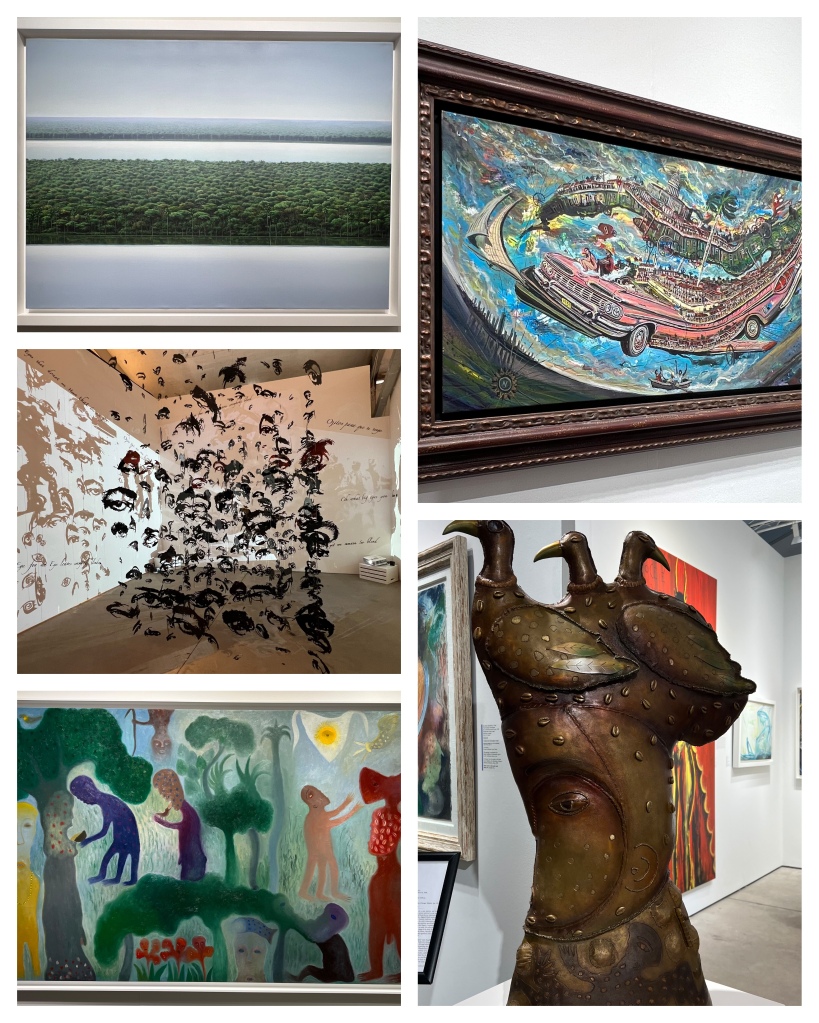
“What a Fair” by Mariya Shevchenko on March 7, 2024
Art Fairs in Miami are held annually to showcase galleries and artists from around the world, requiring significant effort to high skill organization and participation. It takes a lot of hard work and time to not only organize a fair like such, but also for the artists to bring their pieces to this. Artists invest time, money, and their all into their pieces, also often facing setbacks such as damage or having to restart the project. Many have to hire multiple professionals that would install their pieces, whose work frankly speaking is not of the cheapest. It is incredible how art may fit all of the different criterias within, such as politics, faith, culture, and the idea, but yet stay appealing to the eye and spark an emotion. From the digital age of a canvas mimicking your every movement, to Cuban history, we saw it all and even got a chance to interact with multiple artists themselves.
This was not my first time being at a fair that is named Art Wynwood, and frankly will not be my last one. However, I absolutely love being immersed into contemporary arts as though they are something where history is being done in front of us. One highlight was a visit to Ramón Cernuda’s Cuban gallery, featuring Manuel Mendives’ “Olofi, Owner of the Landscape,” which beautifully expressed Yoruba culture. The scenery of this painting shows creatures represented as humans praying to the Supreme Gods in the Yoruba pantheon. What was interesting about this piece is that people are shown as if they are a part of nature and give nature back what they were given. Manuel Mendives, the artist, did a great job showing the importance of his culture and the way it is expressed which I really much appreciated.
Another standout was Vicente Hernandez’s politically charged paintings, depicting Cuban life and immigration struggles. Many of the people were influenced a lot by the Soviet Union ruling, and many of them blindly believed the reality in which they lived. The artist, however, tried to show that by painting the circus with many key symbols being in the circle surrounded by the entertained people. We can also notice another painting, “Por el Mar de Laz Antillas,” with its truth of brutal immigration and willingness to bring your home to a city like Miami.
However, one piece that touched me the most at the fair was the exposition of “Ojitos para que te tengo” made by Teresa Diehl, and where through her art, Diehl calls for peace and an end to global turmoil, using the eyes of world leaders to symbolize the need for change. By making the eyes of real leaders of the word she wanted to represent to all that something about the way people do politics needs to change and change soon. I had a private conversation with her, and what touched me is that all the eyes that we have in the world, we still stay blind to the reality of what we see happen to us and how much longer do we need to stay quiet until we will finally realize. This is exactly what I love about art when we can speak our thoughts and call for action, when we can ask for people to open their eyes and not stay ignorant, especially about issues that happen around the world.
Art allows us to view the world through different lenses, making fairs like Art Wynwood invaluable for both artists and attendees. They serve as platforms for dialogue and reflection, encouraging us to carry new perspectives forward in our lives.
Rubell Museum As Text
“Untouched Topics” by Mariya Shevchenko on March 24, 2024
The Rubell Museum has opened my eyes to a new form of contemporary art collection that I have never seen before. From the works of world-famous artists like Yayoi Kusama, Cady Nolan, Karon Davis, and Basquiat, to a unique sweep of contemporary art that cannot be found anywhere else, this place made me disappear from my reality and away from the real world. Finding out a bit more about the Rubell Museum, I learned that the couple started their collections over 50 years ago, but no museum can be compared to theirs. The museum has 36 galleries, a flexible performance room, an extensive research library, and many more for visitors to enjoy the time being there. Besides having many world-known artists, the Rubell Museum also touches on many subjects through their exhibited artworks, that I have not noticed anywhere else yet.
Starting with Yayoi Kusama, a 95-year-old artist, the Rubell Museum was one of the few places that obtained two of her pieces before she became famous. Unfortunately, Kusama has had a challenging life, dealing with a lot of distress which inspired her to create immaculate art pieces where one can escape from reality. From depersonalization to helping remove the taboo on mental health, Kusama created a transformative experience that visitors of the museum can partake in. One of the rooms designed by her, the “Infinity Mirrored Room,” is made with a kaleidoscopic effect, transporting visitors to an alternate, limitless universe. It almost feels like being in your own “Milky Way,” gazing at the stars, an impression caused by the holes in the wall that allow light to enter and reflect in the mirrors. This experience mesmerizes visitors for a few seconds until they realize they are there by themselves, at peace. Through her art, Kusama has forever marked the contemporary art scene, changing the narrative of mental illness and creating an alternate reality for inner peace.
Another touching art object that made me look at things differently was one by Karon Davis, an artist who creates sculptures and installations to highlight issues of history, race, and violence in the United States. One of the sculptures exhibited in the Rubell Museum is “Family,” depicting an African American family sending off their son to school. The figures were created from real people, using plaster strips and chicken wire to sculpt bodies. Davis even used her real son to make the sculpture. The significant message of this piece lies in the idea that even today, many American schools face the issue of gun violence, leaving students feeling unprotected, especially African American children who feel targeted. The feeling of sending off your child to school, realizing the risks, and feeling powerless is quite dramatic. The sculpture portrays this tragedy by targeting race, which is symbolized by the antlers on the heads of the figures. Davis, herself, also experienced a personal tragedy when her husband, Noah Davis, passed away from cancer in 2015. On their anniversary, she placed a bouquet of flowers under his paintings with a note saying, “With Love – On Our Anniversary, Karon and Noah Davis,” and they have remained untouched since.
I believe the best stories are those lived by simple people like us, with some pinch of salt, whether from sadness, happiness, or excitement. They are real stories. Artists like Yoyumi Kusama and Karon Davis reveal important layers of our society that many people have to overcome and may touch one’s heart. Whether we want to relate to them or be left alone in our world, all are equally valid spectrums of emotions and feelings, and all of those can be portrayed through art.
PAMM As Text
“Uncomfortable, yet rewarding” by Mariya Shevchenko on April 7, 2024.
The Pérez Art Museum Miami (PAMM) is a monument to creativity from all backgrounds. It was renamed in honor of Jorge M. Perez after it was first designed by the Miami-Dade County Art Museum. For almost 35 years, it served as the focal point of the county’s cultural landscape, and being so unique because of its unwavering faith in the transformational potential of art, it strives towards creating a more compassionate and just society. By providing people with immersive experiences with worldwide modern and contemporary art, PAMM also actively engages individuals to stay and think creatively.
Our journey to PAMM was enhanced by the presence of Mr. T. Elliot Mansa, a distinguished artist who guided us throughout the entire visit. I enjoyed listening to Mr. Mansa’s anecdotes and observations, and as turned out later, I soon learned that he is not only a multidisciplinary artist renowned for his ability to incorporate “Southern vernacular aesthetics” into provocative pieces, but also a good friend of Professor Bailly. Thanks to Mr. Mansa, who guided us through various exhibits, I was able to learn about critically important issues related to the political, social, and racial dynamics of different communities.
Since the very beginning of our visit, we were immediately exposed to African American history. Walking through the several galleries of the museum, I felt the reminders of the pervasiveness of systemic racism in the modern world. One of the exhibits there represented the erasing of ideas and voices in a world where intelligence may be made invisible by using chalk whiteboards with pure white chalk. It made me think that no matter how hard or much you try, the ideas will be invisible on the whiteboard, and this system needs to be changed from the roots and not only barely touched on.
My favorite work that we discussed though, was one with Hattie McDaniel, the first African American woman to win an Oscar, being written on a painting. She was subjected to segregation during the event and had to get an award separate from everyone else during that time. As a fan of “Gone With The Wind,” I found it quite poignant to see how discrimination continues to have an impact, as portrayed in both the book and the actress’s actual life. These pieces of art are potent monuments to the ongoing difficulties that Black people have endured throughout history and are something that is still not paid much attention to, yet has been repeated too many times to be impossible to see.
The exhibitions at PAMM forced me to acknowledge racism’s ubiquitous existence in modern culture, going beyond just demonstrating its prevalence. Whether it is portrayed in popular culture, on social media, or in everyday conversations, racism endures and forces us to face hard realities. Nevertheless, as unsettling as these disclosures may be, they work as triggers for important discussion and action. We give ourselves the ability to bring about constructive change in the present and the future by admitting the injustices of the past, and I firmly stand by that. As a reminder, it is important to always have confronting, uncomfortable truths and actively work towards a more equitable and just world, which is the key. I believe that PAMM is the place that inspires dialogues, reflection, and ultimately transformation for such inquiries and systematic issues.









